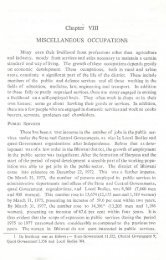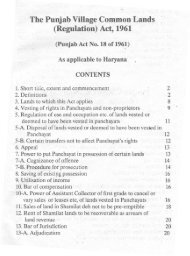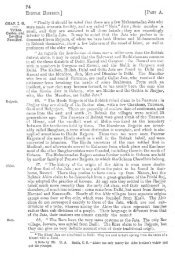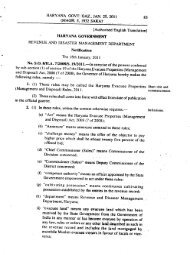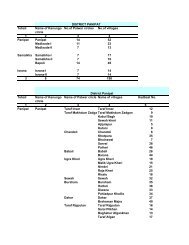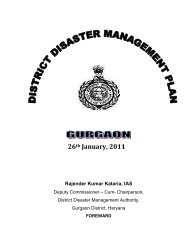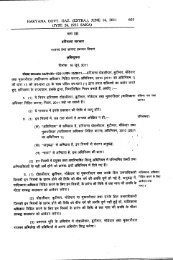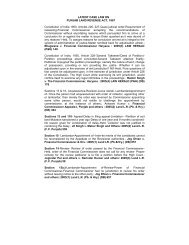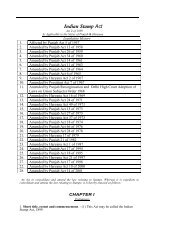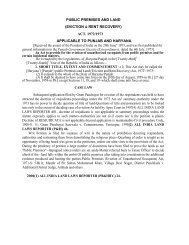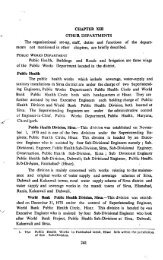CHAPTER XI REVENUE ADMINISTRATION Sirsa seems to beinthe ...
CHAPTER XI REVENUE ADMINISTRATION Sirsa seems to beinthe ...
CHAPTER XI REVENUE ADMINISTRATION Sirsa seems to beinthe ...
You also want an ePaper? Increase the reach of your titles
YUMPU automatically turns print PDFs into web optimized ePapers that Google loves.
<strong>CHAPTER</strong> <strong>XI</strong><br />
<strong>REVENUE</strong> <strong>ADMINISTRATION</strong><br />
<strong>Sirsa</strong> <strong>seems</strong> <strong>to</strong> be in the administrative division of Hisar Feroza Sarkar<br />
during Firuz Shah reign but thereafter it was hardly under any settled government.<br />
In the time of Akbar, <strong>Sirsa</strong> was one of the dasturs of Hisar Feroza<br />
Sarkar. Prior <strong>to</strong> the British annexation, the inhabitants who were mostly<br />
roaming pas<strong>to</strong>ral families, had paid little <strong>to</strong> any ruler. The only revenue<br />
derived from the tract by any chief claiming jurisdiction over it had reached<br />
him in the shape of plunder secured by an armed foray. The Bhattis exacted<br />
one-fourth of the gross produce of the cultivated land but really they <strong>to</strong>ok<br />
what they could get. When the Raja of Bikaner or Patiala who had jurisdiction<br />
over the part of the district, sent forward his subjects <strong>to</strong> colonise the<br />
tract, he ignored the rights of pas<strong>to</strong>ral inhabitants and assumed. authority<br />
<strong>to</strong> grant permission <strong>to</strong> the colonists <strong>to</strong> settle in any place not already occupied.<br />
The colonists w~re req'lired <strong>to</strong> give a certain portion of the produce of their<br />
land which was usually taken in kind. The Sikh Chief of Patiala ordinarily<br />
exacted one-seventh of the gross produce. The Raja of Bikaner,<br />
nothing for the first five years but thereafter he levied his dues in cash at<br />
the ratc of Rs. 2 per plouGh of 10 or 1.2 acreS. J<br />
When the district came under the British, they seem <strong>to</strong> have at once<br />
introduced a system of cash assessments with short leases. These assessments<br />
were based on the estimates of the previous income of the Indian r~lerbut these<br />
were generally so high that these could not be realised in full except in unusually<br />
good year. The actual income from the land revenue each year fluctuated<br />
greatly and depended on the nature of the harvest. Villages were constantly in<br />
arrears and in practice it was decided every year how much could be taken out<br />
of the village. If the demand was not paid in time, the whole of the grain belonging<br />
<strong>to</strong> village was attached and no portion of it was released until the<br />
demand has been paid in cash or good security for future"payment bad been<br />
given. Sometimes, the grain was sold on the account of government<br />
as the owners were unable <strong>to</strong> re,~eem it. 2 The summary settlements effected<br />
by the British were mostly allowed <strong>to</strong> continue in force until the first regular<br />
settleI1lent.<br />
1. J. Wilson, Final Report of the Revision of Settlement of the <strong>Sirsa</strong> District In the<br />
Punjab, 1879-83, p. 318-319.<br />
2. Ibid, p. 390.
The first regular settlement was completed in 1864. It wa, based on the<br />
principle that the land revenue demand was half the net profits of the cultivation<br />
and could be paid in an average year. The settlement was revised between 1879<br />
and 1883 and was enforced with effect from kharif 1881 for a period of 20 years.<br />
An increase of 47 percent was secured over the previous demand and a system<br />
of fluctuating assessment was introduced in<strong>to</strong> villages dependent on floods of<br />
the Ghaggar. The second revision of the settlement was completed between<br />
1901-1902 which was sanctioned from kharif 1903 <strong>to</strong> rabi 1918 and was further<br />
extended <strong>to</strong> the end of 1921. It was based on the average produce estimates,<br />
80 per cent of the half net assets was taken as the revenue demand but the<br />
estimates of prices and yields assumed were very cautious.<br />
The <strong>Sirsa</strong> district was resettled in 1919-1922 and the new assessment<br />
was sanctioned with effect from kh·arif 1922 for a period of 20 years. The district<br />
was divided in<strong>to</strong> three assessment circles known as Rohi, Bagar and NaiL<br />
The incidence of assessment in Rohi circle was 41.1 paise per cultivated acre and<br />
60.9 paise per matured acre. In addition, a nahri parta of 25 paise per acre on<br />
irrigated land in certain estates was also imposed. The Bagar circle was<br />
assessed at the rate of 23.4 paise per cultivated acre and 43.2 paise per<br />
matured acre. In Nali circle, the fixed and fluctuating assessment was levied.<br />
The fixed assessment was at the rate of 43.2 paise per cultivated acre<br />
and 75 paise per matured acre. The incidence of fluctuating assessment<br />
was Rs. 1.56 paise per cultivated acre and 2.79 paise per matured acre.<br />
Besides, nahri porta of 19 paise per acre was levied in 25' villages<br />
irrigated, by the Western Yamuna Canal. The overall inCt'ease over the<br />
previous settlement was 53 per cent (59 per cent in Rohi, 49 per cent in Nlili and,<br />
36 per cent in Bagar) the weak Bagar circle escaping with an increase of only<br />
36 per cent.<br />
The settlement worked well except in the years of bad rainfall and the<br />
collection was 99 per cent in 1923-24, 93 per cent in 1925-26,99 per cent in 1926-<br />
27 and 83 per cent in 1927-28. Thereafter, due <strong>to</strong> successive failure of crops,<br />
the collection of revenue dropped <strong>to</strong> 61,64 and 62 per centin 1929-30, J 930-31<br />
& 1931-32 respectively. The hardship was further aggravated due <strong>to</strong> fall in prices<br />
in thirties and subsequent failure of crops and famine conditions in 1932-33,<br />
1936-37, 1938-39, 1939-40, and 1940-41. The prices began <strong>to</strong> rise in 1941 and<br />
land owners were better off thereafter. The settlement sanctioned up<strong>to</strong> 1942<br />
ran for several years. The land revenue fixed at the last settlement had lost its<br />
relationship with income from land. There was a lot of increase in irrigated<br />
acreage and other fac<strong>to</strong>rs combined <strong>to</strong> bring prosperity <strong>to</strong> land owners.<br />
The government in order <strong>to</strong> avail a share of the enhanced income from<br />
land, levied surcharge in 1954 under the Punjab Land Revenue (Surcharge)<br />
Act, 1954. Under the Act, every landowner who paid revenue in excess of Rs 10
was liable <strong>to</strong> pay a surcharge thereon <strong>to</strong> the extent of one quarter of land revetle<br />
if the amount payable by him as land revenue did not exceed Rs. 30, and two<br />
fifth of the land revenue if it exceeded Rs. 30.<br />
The special charge was levied under the Punjab Land Revenue (Special<br />
Charges) Act, 1958, from the rabi harvest of agricultural year 1957-58. The<br />
rate of special charge was based on the income tax pattern with different slabs<br />
for different categories of land-owners. The slab rates were such that the incidence<br />
of special charge mainly fell on those who could afford <strong>to</strong> pay it. While<br />
the land holders paying revenue ('Land revenue' plus surcharge) up <strong>to</strong> Rs. 50<br />
had been exempted from the provisions of the Act, those paying more than<br />
Rs. 1,000 were subjected <strong>to</strong> 300 per cent incre.,se in land revenue.<br />
A cess on commercial crops namely, cot<strong>to</strong>n, sugarcane and chilly at the<br />
rate of Rs. 4 per acre in the case of land which was irrigated by canal water and<br />
Rs. 2 per acre in case of other land had been levied from kharif 1963 under the<br />
Punjab Commercial Crops Cess Act, 1963. Areas under commercial crops,<br />
sown solely for domestic use up<strong>to</strong> one kanal in the case of chilly and 2 kanals<br />
in the case of sugarcane or cot<strong>to</strong>n were exempt from this levy.<br />
An additional surcharge on the land revenue at the rate of 50 per cent<br />
was levied for the development of Kurukshetra University/<strong>to</strong>wn III 1967. Initially,<br />
this had been levied for kharif 1967 and rabi 1968, but it was extended for<br />
kharif and rabi harvests of the agricultural year 1968-69, under the Haryana<br />
Land Revnue (Additional Surcharge) Act, 1969. The levy of additional surcharge<br />
was further extended up<strong>to</strong> 1973-74 but it could only be collected up<strong>to</strong><br />
1972-73on account of the en.forcenwnt of the Haryana Land Holdings Tax Act,<br />
1973. .<br />
The state government <strong>to</strong>ok the view that the collection ,of these levies<br />
had become cumbersome not only for the revenue agency but also for the cultiva<strong>to</strong>rs.<br />
To meet the situation, the Haryana Land Holdings Tax Act, 1973<br />
repealed the Punjab Land Revenue (Surcharge) Act, 1954, the"Punjab Land,<br />
Revenue (Special Charges) Act, 1958, the Punja.b Commercial Crops Cess Act<br />
1963and the Haryana Land Revenue (Additional Surcharge) Act, 19.69and consolidated<br />
these levies in<strong>to</strong> a single tax known as the land holding tax. However,<br />
the land holding tax shall not be levied and charged on land which is liable <strong>to</strong><br />
special assessment under Section 59 of the Punjab Land Revenue Act, 1881, or<br />
the Punjab Land Revenue (Special Assessment) Act, 1966. Further, during<br />
the period the above tax is levied and charged, the land shall not be liable <strong>to</strong><br />
payment of land revenue by way of general assessment under the Punjab Land<br />
Revenue Act, 1881, or the payment of local rate under the Punjab Panchayat<br />
Samitis and ZiIa Parishads Act, 1961. The Act brings out a concept of holdings<br />
on the basis of a family rather than the individual as a unit for the purpose<br />
of imposition of tax and provides for graded taxation on the basis of holdings'
192 SIRS.\ DISTRICT GA.ZBTTBBR<br />
size. The present (1981) rates of land tax are as under<br />
Class ofland<br />
(specified in<br />
Schedule I)<br />
Comprising the<br />
land holding<br />
(a) Seventy paise per 0.05 hectare for the first one hectare ;<br />
(b) One rupee per 0.05 hectare for the next four hectares ; and<br />
(c) One rupee and thirty-five paise per 0.05 hectare for remaining<br />
land.<br />
(a) Sixty paIse per 0.05 hectare for the first one hectare ;<br />
(b) Ninety paise per 0.05 hectare for the next four hectares.<br />
and<br />
(c) one rupee and twenty paise per 0.05 hectare for the remaining<br />
land.<br />
(a) Forty paise per 0.05 hectare for the first one hectare ;<br />
(b) Fifty paise per 0.05 hectare for the next four he~tares ;and<br />
(c) Sixty paise per 0.05 hectare for the remaining land.<br />
(a) Ten paise per 0.05 hectare for the first one hectare ;<br />
(b) Fifteen paise per 0.05 hectare for the next four he'?tares ;<br />
and<br />
The landowners of land holdings measuring 2.5 hectares or less were<br />
exempted from the payment of this tax with effect from November 15, 1978 by<br />
the Haryana Land Holdings Tax (Amendment) Act, 1978. Later a surcharge<br />
at the rate of 10 per cent on holdings exceeding 4.80 hectares but not exceeding<br />
6 hectares and 15 per cent on holdings exceeding 6 hectares was levied with effect<br />
from June 16, 1979.<br />
(1) Bagar<br />
(2) Nali<br />
(3) Rohi
Assessment<br />
Circle<br />
<strong>Sirsa</strong> .. Hagar Nehri Nehri Unirri- Banjar<br />
(perennial) (Non- gated Kallar,<br />
perenial Tal area Thur and<br />
Chahi Sem<br />
Dabwali Nali do do do do<br />
Rohi do do do do<br />
Special Assessment.-The Punjab Land Revenue Act, 1887 was amended<br />
by the Punjab ActXnI of 1952 <strong>to</strong> provide for special assessment of land put <strong>to</strong><br />
non-agricultural use i.e. brick kilns, fac<strong>to</strong>ries, cinemas, shops, hotels, houses,. and<br />
landing grounds and other similar purposes. The work of special assessment<br />
was started in 1955. In the mea.ntime, it was decided <strong>to</strong> levy the special asSessment<br />
on ~. 1 hoc basis as a multIple of the existing land revenue with kharif ,<br />
1955. Exemption wa.s provided for hill areas including sub-mountainous areas<br />
(for 10 years) ; gardens ; orchards; houses occupied by owners for agricultural<br />
purposes or purposes sub servient <strong>to</strong> agricUlture; small-scale cottage industries<br />
(for 10 :1ears) ; and for any public, charitable or religious purpose. It was<br />
further provided that residential hQuses in occupation by owners, with a<br />
rental value not exceeding Rs. ·300 would be exempted from special<br />
assessment. The enforce ment of special assessment was suspended from<br />
kharif 1964.<br />
LAND REVENU~ AND SPECIAL CESSES<br />
Land Holding Tax.-The Land Holdings Tax ~ct, 1973 was enforced in<br />
1973 abd thereafter the collection of land revenue, sutcharge, special charge,<br />
eesson commer
SIRSA DISTRICT GA.ZBTTSBR<br />
"!I '<br />
only land holding tax was collected. The collection of land holding tax during<br />
1975-76 <strong>to</strong> 1980-81is given below<br />
Year ending Land Holding Tax<br />
(Rs)<br />
1975~76 t 58,35,220<br />
1976-77 :58,49,746<br />
1977-78 "58,62,836<br />
1978-79 46,01,498<br />
1979-80 (35,66,444<br />
1980-81 {42,85,6l7<br />
Special Cesses.-The cesses levied in the district included school cess,<br />
road cess, Patwari cess and Lambardari cess. In 1871, the local rate was imposed<br />
at 61 per cent raised <strong>to</strong> 8f per cent in 1878. Thus in 1878, the cesses were<br />
school cess at 1 per cent of land revenue, road cess at 1 per cent, Patwari cess at<br />
61 per cent, Lambardari at 5 per cent and local rate at 8f per cent. These<br />
cesses added with rent of newly cultivated land, cost of village watchmen and<br />
messengers, common expenses of the village including stationery .of Patwari<br />
and repairs of his office and later imposed post cess of lper ,cent amounted <strong>to</strong><br />
35 per cent of the land revenue demand. These cesses swallowed up.a ~nsid,erable<br />
proportion of half net prpfits of cultivation. The leaders of original body<br />
of colonists came <strong>to</strong> be known as Lambardars and ~n the introduction of the<br />
British rule, the lease granted <strong>to</strong> the village communitie~ were made out in the<br />
name of those headmen. The headmen were representatives of the village<br />
communities in its transaction with the government; they signed engagements<br />
for whole village and collected the land revenUe and other dues and paid them<br />
in the treasury:. In 1862, it was found that in many villages there were as many<br />
headmen as proprie<strong>to</strong>rs. Therefore, one or two according <strong>to</strong> the size of the<br />
village were selected as headmen and the others were left out as proprie<strong>to</strong>rs only. '<br />
During the revision of settlement, 1879-83,Zaildars were appointed against,<br />
the payment of 1 per cent of the revenue realised by the government. Thus<br />
there were 34 Zaildars in the then <strong>Sirsa</strong> area, with an average annual emoluments<br />
of Rs; 62 in <strong>Sirsa</strong> and Rs'. 37 in Dabwali. The Zails were very small and<br />
in many cases, these were very much scattered. During the settlement of 1901-<br />
02, the scattered Zails were apportioned among neighbouring Zaits and their<br />
number was reduced <strong>to</strong> 20. The Zaildars were graded in<strong>to</strong> 3'categories, 2 Zaildars<br />
at Rs. 200 e~ch, 5 at Rs. 150 each and 13 at Rs. 100 each. 'Besides, 10<br />
Inamdars at Rs. 5P each were appointed.
Ti1l1948, Zaildars and Inamdars continued <strong>to</strong> supervise and assist in the<br />
collection of land revenue. These institutions were finally abolished in 1952<br />
and nOw only Lambardars are responsible for the revenue collection. Prior<br />
<strong>to</strong> the enforcement of the Land Holdings Tax Act, 1973, the Lambardar was<br />
~ paid pachhotra ~t the rate of 5 per cent of land revenue. Since various levies<br />
were consolidated in<strong>to</strong> land holding tax, the lambardars' allowance was fixed<br />
at 3 per cent of the new tax. The allowance was again raised <strong>to</strong> 5 per cent in<br />
1980-81.<br />
Local rate has grown from small beginnings. It included road, school<br />
and post cesses. These cesses were later consolidated in<strong>to</strong> local rate of 1O~<br />
per cent of land revenue. It was subsequently enhanced a number of times and<br />
was later governed by the Punjab Panchayat Samitis and Zila Parish ads Act,<br />
1961, when it was 50 per cent of the land revenue. With the enforcement of the<br />
Haryana Land Holdings Tax Act, 1973, it was decided that during the period<br />
the land holding tax is levied, the land shall not be liable <strong>to</strong> the payment of<br />
<strong>to</strong>cal rate.<br />
The Patwari cess had been fixed at6! per cent on the land revenue, but<br />
in some of the villages it had been fixed at 10 per cent. In tahsil Dabwali, a<br />
patwari was entitled <strong>to</strong> levy 1 per cent on the rent of all land broken up from the<br />
prairie after settlement. In 1880, the Patwari cess was founded and appropriated<br />
in fund from which Patwaris were paid. Besides, the Patwari cess was fixed<br />
uniformally at 61 per cent on land revenue. The Patwari cess was remitted in<br />
1906.<br />
Water rate.-Water rates (occupier's rate) were initially levied on the area<br />
irrigated during each crop under the Northern India Canal and Drainage Act,<br />
1873 which was later replaced by the Haryana Can~'md Drainage Act, 1974.<br />
The rates were revised a number of times and the last revision made in rabi 1949.<br />
The income for 1975-76 <strong>to</strong> 1980-81 is given below<br />
Year ending rabi Amount (Rs.)<br />
-------.;---<br />
1975-76 1,4fr,25,166<br />
1976-17 1,39,98,994<br />
1977-78 1,47,35,696<br />
1978-79 1,48,44,559<br />
1979-80 1,11,34,432<br />
1980-81 1,83,99,001<br />
Betterment charges.-Betterment charges are levied under the Punjab<br />
RettermentCharges and Acreage Rates Act, 1952. It is levied on areas served
y irrigation projects <strong>to</strong> recover part of the cost of the projects. . The income<br />
from 'this levy from 1975-76 <strong>to</strong> 1980-81 is given below.<br />
1975-76<br />
1976-77<br />
1971'..78·<br />
1978-79<br />
1979-80<br />
1980-8,1<br />
'<strong>REVENUE</strong> <strong>ADMINISTRATION</strong><br />
IncoD1e,(Rs~)<br />
22,18,4~1<br />
1,08,765<br />
23,19'1<br />
18,094<br />
4,716<br />
2,355<br />
An estate, which is usually identical <strong>to</strong> a village, is the unit of revenue<br />
administration. Each estate is indtvidually assessed and its record of rights and<br />
registers of fiscal and agricultural statistics maintained separately. All the<br />
proprie<strong>to</strong>rs are by law jointly responsible for payment of land revenue. However,<br />
this is only in theory but not in practice. Individual proprie<strong>to</strong>r is himself<br />
responsible for the payment of land revenue and other charges. Each estate is<br />
represented by one or more Lambardars in its dealings with thegovemment.<br />
Estates are grouped in<strong>to</strong> patwar circles under the charge of aPJl.tw~ri, while 15<br />
<strong>to</strong> 20 circles form the charge of a Kanungo, whose duty is <strong>to</strong> supervi$ethe work<br />
of Patwaris.<br />
In March 1981, the district was divided in<strong>to</strong> tahsils, kanungo circles.<br />
patwar circles and revenue estates as follows .-<br />
<strong>Sirsa</strong><br />
Dabwali<br />
<strong>Sirsa</strong><br />
Dabwali<br />
Total<br />
No. of<br />
Tahsildars<br />
No. of<br />
Naib<br />
Tahsildars<br />
No. of No. of<br />
Office Asst1,<br />
Kanungos Office<br />
Kanungos<br />
Number of No. Of :<br />
Kanungo PatWar.,<br />
Circles Circles<br />
158<br />
69<br />
No. of<br />
Patwaris<br />
146<br />
71<br />
217<br />
No. of<br />
Revenue<br />
Estates<br />
~39<br />
84<br />
323<br />
No. of<br />
Asstt.<br />
Patwaris
The head of revenue administration in the. district is t~ Collec<strong>to</strong>r .(DeRU,ty·<br />
CoIllmissioner). He is a steward of the st~te and is bound <strong>to</strong>. respee1a\ld<br />
preserve from encroachment every private right in the soil, which has been ~ea~<br />
or confirmed by the state. He must ensure and assist in the measures <strong>to</strong><br />
prevent the damage <strong>to</strong> crops from causes which are in L.j degree controllable<br />
by man. He must encourage and assist in every effort made' by a right holder<br />
for the development of his estate~ The Sub-Divsional Officer (Civil) is the co<br />
Assistant Collec<strong>to</strong>r Grade-I but as a measure of decentralisation, the powers of<br />
Collec<strong>to</strong>r under certain Acts have been delegated <strong>to</strong> him for the tahsil which<br />
falls in his areas.<br />
The Tahsildar is an important officer and incharge of the tahsil for<br />
revenue work including revenue judicial work. He has <strong>to</strong> control the Patwar<br />
and kanungo agencies. He ensures the collection of revenue in time, <strong>to</strong> point<br />
out promptly <strong>to</strong> the Collec<strong>to</strong>r any failure of crop or natural calamities, which<br />
renders suspension or remission necessary and <strong>to</strong> carry out within h~s own<br />
sphere, other duties concerning land revenue administration. His work<br />
involves extensive <strong>to</strong>uring, providing opportunities <strong>to</strong> deal on the spot w:tp.<br />
partition cases and other matters connected with the appointment of Lambardars,<br />
lapses of land revenue assignments, etc.<br />
The Patwar' is appointed for a circle consisting of one or more villages.<br />
Besides the proper maintenance of record, the Patwari is required <strong>to</strong> report <strong>to</strong><br />
the Tahsildar any calamity affecting crops, cat~le or the agricultural classes and<br />
<strong>to</strong> bring <strong>to</strong> his notice alluvial and diluvial action of rivers, encroachment of<br />
government land, the death of revenue assignees and pensioners, the progress<br />
of work made under the agricultural loans and similar laws and the emigration<br />
and immigration of cultiva<strong>to</strong>rs. He undertakes survey a,nd· field inspection,<br />
aides in other government activities like distribu,tion of relief etc., prepares<br />
papers showing the land holding tax demand due from eaj;h la~downer and<br />
furnishes all information that may be required <strong>to</strong> facilitate the collections.<br />
He himself is not permitted <strong>to</strong>take any part in the collection of the re.venue except<br />
when any Lambardar refuses <strong>to</strong> acoept <strong>to</strong>tal demand from each landqwQ~<br />
and no immediate alternative arrangement can be made.<br />
The Patwari is under the immediate supervision of circle supervisor<br />
known as Kanungo. The Kanungo is responsible for the conduct and work<br />
of Pat waris. He constantly moves about his circle, supervising the work of Patwaris,<br />
except in the month of September when he stays at tahsil ht:;adquarters<br />
<strong>to</strong> check jamabandis received from Patwaris. There is~an Office Kanungo in each<br />
tahsil who is Tahsildar's revenue assistant. His chief work is the maintenance<br />
of revenue records. He has also charge of the forms and stationery requireli<br />
by Patwaris, keeps the accounts of mutation fee, records the rai:\l.falland<br />
maintains the registers of a.ssignees of land reWUlle and other mi$ceU~J\e()us
evenue registers. He is the cus<strong>to</strong>dian of all the records received from Patwaris.<br />
A well-ordered Kanungo office is an important fac<strong>to</strong>r in the revenu~management<br />
of a tahsil.<br />
At district headquarters, there is a Sadar Kanungo assisted by a Naib<br />
Sadar Kanungo. The Sadar Kanungo is responsible for the efficiency of<br />
Kanungos and is normally in camp inspecting their work for atleast 15 days<br />
in every month from Oc<strong>to</strong>ber <strong>to</strong> April. He is the keeper of all records from<br />
Kanungos and Patwaris. He maintains copies of prescribed statistical registers<br />
for each assessment circle, tahsil and the district.<br />
The <strong>Sirsa</strong> district, owing <strong>to</strong> its recent colonization and development,<br />
offers facilities for the novel study of growth of landed rights. Rarely the<br />
his<strong>to</strong>ry of rights in land go back further than <strong>to</strong> the social upheaval caused by<br />
the Chalisa famine of 1783. Prior <strong>to</strong> the famine, village communities were<br />
very sparsely scattered over the area at long distances from each other. Each<br />
separate household or family would break-up and cultivate what little land<br />
was required for its sustenance without interference from any other inhabitant,<br />
the cultivation being in scattered patches round the inhabited site. The<br />
demand of the state was distributed over land or over cattle or partly over the<br />
one or partly over the other. Cultiva<strong>to</strong>rs were constantly throwing up their<br />
holdings in seasons of scarcity and moving off <strong>to</strong> places where conditions were<br />
more favourable. The difficulty under such circumstances was of course,<br />
<strong>to</strong> get sufficient land cultivated. Up<strong>to</strong> this period, nothi11lgof the nature<br />
of the landed rights as between individuals had come in<strong>to</strong> existence.<br />
When the terri<strong>to</strong>ry comprising the present <strong>Sirsa</strong> district came under, the<br />
British rule, there were only some 30 villages along the Ghaggar and none<br />
in the sandy tract <strong>to</strong> the south nor in the dry tract <strong>to</strong> the north. As soon as<br />
the British authority was felt in the area, the colonists from adjabent areas<br />
in the south-east and south-west came <strong>to</strong> the sandy and dry tract of the district<br />
successively and founded villages which they held subject <strong>to</strong> the payment<br />
of a share of produce <strong>to</strong> the ruler under whose auspices they had settled.<br />
The first step in the development of any landed rights was the<br />
demarcation of the jurisdiction oreach estate. This was done between 1828<br />
and 1838. The district was then found <strong>to</strong> be more or less sparsely occupied<br />
by village communities collected in<strong>to</strong> inhabited sites and cultivating and<br />
pasturing their cattle on the adjacent vacant land. Such lands were not<br />
demarcated by any fixed or definite boundaries. The unit of administration<br />
was inhabited site and not any precisely defined block of land. The joint<br />
claim of village community of the land round their homestead was recognised<br />
in 1837.
Within the village community, there were two types of development.<br />
In the bhayachara (brotherhood) villages, each individual family could<br />
cultivate such land as it needed. When the demand was collected in kind<br />
each cultiva<strong>to</strong>r paid a fixed share of its produce and when it was paid in cash<br />
the proportionate share due on its cultivation was paid.<br />
In boladari villages, the headmen had been flOm the first somet~dng<br />
more than the leaders of a band of colonists. His position had been rather<br />
that of lessee from the state, settling cultiva<strong>to</strong>rs in the leased lands. The term of<br />
the original lease, whether from Indian rulers or the British, implied that the<br />
lease was in their favour alone. They levied fixed rents on the cultiva<strong>to</strong>rS<br />
(boladars). They were responsible for the state demand and all loss arising from<br />
their income of rents in any year, being less than the state demand, caused due<br />
<strong>to</strong> absconding :cultiva<strong>to</strong>rs or other causes was borne by them. Thus, Lambardars<br />
or headmen were in a superior position and the cultiva<strong>to</strong>rs were left in undisturbed<br />
possession so long the cus<strong>to</strong>mary rent waS paid. They were not concerned<br />
with profits or losses of the village administration or determination of the<br />
common village expenses. This tenancy passed on <strong>to</strong> the sons of cultiva<strong>to</strong>r<br />
on his death.<br />
During the settlement of 1852, in boladari villages, Lambardars were<br />
declared proprie<strong>to</strong>rs of whole of the village and cultiva<strong>to</strong>rs settled by them were<br />
declared <strong>to</strong> be tenants. In bhayachara villages, the men in whOSename~, asthe<br />
leaders of the community, the original permission <strong>to</strong> settle had been ma,de out,<br />
were declared as proprie<strong>to</strong>rs and the other cultiva<strong>to</strong>rs were merely their tenants.<br />
The loss of their incipient proprie<strong>to</strong>ry rights by many proprie<strong>to</strong>rs 'in<br />
bhayachara villages was <strong>to</strong> some extent compensated by a wholesale creation·<br />
of occupancy tenures. Practically, all tenants except those who had. settled<br />
in a village very recently or who occupied a distinctly inferior position were made<br />
occupancy tenants, all other tenants being declared <strong>to</strong> be tenants without right<br />
of occupancy. This was the Caseboth in the bhayachara and boladari villages.<br />
The rent of the occupancy tenants was also fixed so as <strong>to</strong> leave the proprie<strong>to</strong>rs<br />
in bhayachara villages a profit (malikana or bi~wedari) of 5 <strong>to</strong> 10 per cent, on the<br />
land revenue after paying the land revenue and cesses, and of 50 <strong>to</strong> 100 per cent<br />
in boladari villages. In the latter, the proprie<strong>to</strong>rs paid cesses out of his<br />
mafikana'.l Accordingly 7 per cent of the area was held,by tenants-at-wiIl,<br />
27 per cent by proprie<strong>to</strong>rs and 66 per cent by occupancy tenants.a<br />
After the settlement of 1852-63, the tenants rapidly extended their<br />
cultivation at the rates fixed at settlement and the proprie<strong>to</strong>rs, of course made<br />
no objection as the greater the area of land brought under cultivation th~<br />
1. Hisar Distr kt Gazetteer, 1892 P. 165<br />
2. J. Wilnn, Final R!port on the Revision Of Settlement o/the SirsQDistrict in the Punjab.<br />
1879-83 p. 330.
larger were' their profits. This state of things continued till the seftlen:lent of<br />
1879•....83 drew near, when the increased competition f'Ot) ;and t4f.<br />
OODSeqllent increased.' value of land induced ~oprie<strong>to</strong>r$" td" St'-op rleW<br />
¢ultivatiun exeept at kigher rents and <strong>to</strong> demand higher rents fOt' land \vhich<br />
had been brought 1ltt4.er cultivation since settlement. The tenants in the<br />
expectation ofa further 8l'ant of occupancy rights at settlement refused <strong>to</strong> pay<br />
Iiigher rents and the consequence was a larger number of ejectment proceedings<br />
'under, the Tenancy Act of 1868. These tenants met with claims for<br />
occupancy rights, 'but the Act in questioll,~~v~no substantial support/<strong>to</strong> such<br />
claims. After a p,roposal for special legislation had been negatived the tenants<br />
claims were in the great majority of cases rejected 'and in respect of lands<br />
brought under cultivation after 1868, the tenants had <strong>to</strong> pay. the proprie<strong>to</strong>rs'<br />
demand .or be ejected. Such a step:brought many a tenant, whose occupancy<br />
hold,ing conferred at the previous settlement was not large enough <strong>to</strong> support<br />
him and his family, \ in<strong>to</strong> the greatest difficulties. 1<br />
, The above situation of tenant right made clear the importance of the<br />
tenlttlt element in the socio-ecOnomic condition of the district. Later the<br />
Punjab Tenancy Act of 1887 was enacted but this Act hardly provided any<br />
security <strong>to</strong> tenants. Most of the suits were decided against the tenants. The<br />
following table would show the cultivating occupancy in the disbict after the<br />
enllctment of Punjab Tenancy Act of 1887:-<br />
1891<br />
1901-02<br />
1911-12<br />
1,921-22<br />
1'931-32'<br />
Proprie<strong>to</strong>rs Tenants with<br />
Occupancy<br />
Rights<br />
Tena~t')<br />
at Will<br />
It will be seen from the above table that the proportion of the cultivated<br />
atea in the hands of tenlihts rises <strong>to</strong> 75 per cent and the above account oftbe<br />
development of tenancy tenures will explain, this feature.
A.fterlnclependen~, the. government decided <strong>to</strong> bring land reforms ~<br />
e&POcially<strong>to</strong> carry out its policy of 'land <strong>to</strong> the tillers' in ortler <strong>to</strong> improv.e<br />
the conditions of tenants and increase agricultural production. The following<br />
l~gislations .are applicable ,in the district :-<br />
1. The East Punjab Utilisation .of Lands Act, 1949<br />
2. The Punjab Abolition of Ala Malikiyat and Talukdari Rights Act,<br />
1952<br />
3. The Punjab Occupancy Tenants (Vesting of Proprie<strong>to</strong>ry Rights)<br />
Act, 1952<br />
4. The Punjab Security of Land Tenures Act, 1953<br />
5. The Punjab Bhudan Yagna Act, 1955<br />
6. The Punjab Resumption of Jagirs Act, 1957<br />
7. The Punjab Village 'Common Lands (Regulation) Act, 1961.<br />
8. The Haryana Ceiling on Land Holdings Act, 1972.<br />
Under the East Punjab Utilisation of 'Lands Act, 1949 the government<br />
enforced ;the •optimum utilisation of oultivableland, and any land left ·uncultiva100<br />
;for ·;~.or -more ,consecutive harvests was acquired and leased out .fora<br />
'term>raoging from seven years<strong>to</strong>.twenty years for cultivation, priority being<br />
.given <strong>to</strong>.Harijans. 'Under the provisions of:the Act, no land was taken over<br />
in ;iliis,distriot.<br />
Under the Punjab Abolition of Ala Malikiyat and Talukdari Rights<br />
Act, 1952 the rights of an ala malik in the land held by an a,dnamalikwere<br />
abolished and the adna malik was required <strong>to</strong> pay compensatiop for<br />
proprietary rights. '<br />
The Punjab Occupancy Tenants (Vesting of ·Proprietary Rights) .Act,<br />
1952, declared all occupancy tenants as owners of the land. .<br />
:file Ptmja b Sec1lrityof land Tenures Act, 19'53pro\lided protection <strong>to</strong><br />
·tbej,enantsagainst ejectment andconfel1'ed!fights!on them'<strong>to</strong> pre-empt andJpur~<br />
chase theirltmlaucy. ineertain .oircumstances, and fixedaceiliqgonrtihe landholdings<br />
and utilize the surplus area for resettlement of ejected tenants, landless<br />
labo\l1'ers. and small land owners. The ceiliqg fixed fo~ the land holdings was<br />
30. ~tandard acres for local owners and 50 standard acres for dl~placed persons<br />
froni Pakistan.<br />
_' ~y March' 1981,9994 cases of surplus.land were decided and 13,342<br />
hectares of land was declared surplus in the district. The-resettlement of eligible<br />
tenants on 5,606 hectares waS done by March 1981.<br />
;Jlbe .state gONernmentgives financial. assistance <strong>to</strong> the tenants and land·<br />
,lessl.griGU-\lwallabouters who are resettled on the sU1;plusarea for reclamati~n_<br />
and also advances loan for building houses and sinking wells.
In 1972, on the recommedation of the Central Land Reforms Committee.<br />
th., Uuya.!la Ceiling on La.nd Holdings Act, 1912 was enacted. This Act repealed<br />
the provisions of the two earlier Acts in so far as they relate <strong>to</strong> the ceiling<br />
on land-holdings and utilization of surplus area. The new Act provided for the<br />
assessment of permissible area in relation <strong>to</strong> a family instead of an individual,<br />
and reduced the permissible area limit <strong>to</strong> 1.25 hectares of land under assured<br />
irrigation capable of growing at least two crops in a year, 10.9 hectares of land<br />
under assured irrigation capable of growing at least 1 crop in a year or 21.8<br />
hectares in respect of any other land including banjar and land under orchards.<br />
In case, the family comprises more than three minor children, an additional<br />
area at the rate of ,1/5th of the permissible area of the primary unit is' permitted<br />
for each additional member, provided that the <strong>to</strong>tal dC1esnot exceed twice<br />
the permissible area of the unit. The head of a primary unit has also been<br />
given a right <strong>to</strong> select for each of his major sons (or widow and minor children<br />
of a predeceased son) area equivalent <strong>to</strong> the permissible limit of primary unit.<br />
Further, unlike the Punjab Security of Land Tenures Act, 1953, the new Act<br />
provided for vesting the rights of surplus area in the government and fodts<br />
utilization for settlement of tenants and other economically weaker sections<br />
of the society, for example members of the Scheduled Castes and Backward<br />
Classes, landless persons, agricultural workers and others. By March 1981 a<br />
surplus area of 5,606 hectares was distributed among 4,012 persons in theo<strong>Sirsa</strong><br />
district.<br />
The Punjab Bhudan Yagna Act, 1955 was passed <strong>to</strong> promote. the<br />
Bhudan movement, with the object of resettling landless cultiva<strong>to</strong>rs on larid<br />
received through voluntary donations. The area of 545 acres Of land was'<br />
received in Bhudan movement by March 1981.<br />
Under the Punjab Resumption of Jagirs Act, 1957 all jagirs, 11'IfJ(lfis and<br />
]aglr pensions excepting military jagirs or grants made <strong>to</strong> religious or charitable<br />
institutions granted on or before August 4, 1914 were resumed ..<br />
Consolidation of Land Holdings.~The consolidation or'lllI).d 1lO1dings<br />
was started during the British period in 1920 through Cooperative ci,n~olidation<br />
societies. After Independence, the urgency of consolidation was'lrealised<br />
and the East Punjab Holdings (Consolidation and Preve, ti~: Qf Fragmen tation)<br />
Act, 1948, was passed.<br />
.>f, I.•<br />
Under the Act, the work of consolidation of land holdings in the <strong>Sirsa</strong><br />
district was started in year 1959and has been completed in 322 villages; by march<br />
31, 1981. The work remains <strong>to</strong> be taken up onlyiri one village (Desu<br />
Jodha. Dabwalitahsil). . :.
U'Vll~' ADMINISTRA,TION<br />
OTHER SOURCES OF <strong>REVENUE</strong>, STATE AND CENTRAL<br />
State Sources of Revenue<br />
11'1 addition <strong>to</strong> the' land, there are various other sources from which<br />
the state derives its revenue. A brief description of these is given below:<br />
Stamp Duty.~This duty"is collecte(under the Court Fees Act, 1870, and<br />
the Indian Stamp Act, 1899. The former was enforced on Aprill, 1870, and<br />
thelatter on July 1, 1899. Both these Acts were amended a number of times.<br />
The Court Fees Act was last amended by the Court Fees (Haryana Amendment)<br />
Act, 1974. The Stamp Duty Act was last amended by the Haryana Act, No.<br />
1 of 1967. Both these Acts required _the Collec<strong>to</strong>r (Deputy Commissioner),<br />
District and Sessions Judge and all the Sub-Judges <strong>to</strong> ensure that the applications<br />
for all suits and otherrelevan t documen ts are properly stamped according<br />
<strong>to</strong> schedule. The collection of court fee and stamp duty under these Acts<br />
during 1915-16 <strong>to</strong> 1980-81 has been as under:<br />
Judicial (under<br />
the Court<br />
Fees)<br />
Non-judicial<br />
(under the<br />
Stamp Act)<br />
(Rs) (Rs) '(Rs)<br />
1914-15 4,67,155 60,54,445 65,21,600<br />
(1-7-74 <strong>to</strong> 31-3-1915)<br />
1975-76 1,37,487 84,99,371 82,36,~58<br />
,.<br />
1976-77 7,92,976 58,03,445 65,~6,421<br />
1977-18 "'\ 9,99,394 1,03,55,338 1,13,54,732<br />
1918-79 9,86,941 1,23,30,151 1,33,11,104<br />
1979-80 10,88,341 1,48,00,776 1,58,89,117<br />
1980-81 It 11,45,496 1,60,24,821 1,11,10,311<br />
Registration Fee.- The Deputy Commissioner is the Registrar in the<br />
district. The TahsiIdars and Naib-TahsiIdars are Sub-Registrars and Joint<br />
Sub-Registrars respectively.<br />
Appeals from the orders of the Sub-Registrars are heard by the Registrar.<br />
The Inspec<strong>to</strong>r General of Registration, Haryana, exercises a general superin.<br />
tendence over a,l1the registration offices in the state and has power <strong>to</strong> make<br />
rules .'con~istent with the Indian Registration Act, 1908.
~<br />
Administration of Excise and Taxation.-For the ;dministration of Excise<br />
and Tax.ation Acts, the district is under the eharge of the District EX
Excise and Taxation Officer is incharge of the' enfor.cementwing,of the department<br />
in the district and also functions as the supervising officer of the sales<br />
tax check barriers and passengers and goods tax branch. 'Besides sales 'tax work,<br />
the District Excise and Taxatioo.lOff;cea; .has·<strong>to</strong> do work. under all other Acts<br />
being administered by the department. Th~ Additional Ex~ise and Taxation<br />
Officer and the Assistant Excise and Taxation Officers do mainIy sales <strong>to</strong> work.<br />
In, addition <strong>to</strong>"the sale!!tax work, the, Aasistant IExcise and Taxation: Officers<br />
have <strong>to</strong> attend work pertaining <strong>to</strong> the Pofessiolli' TaK Actal&o. The Excise and<br />
Taxation Officers are authorised <strong>to</strong> exercise the powers of an assessing authority<br />
in relation <strong>to</strong> all dealers, without any Iimicof gros's turnover, within their<br />
terri<strong>to</strong>rial jurisdiction. The Assistant Excise and Taxation Officers are<br />
authorised <strong>to</strong> exercise such powers in cases where the gross turnover does not<br />
e..
4. The Opium Act, 1878.<br />
5. The Dangerous Drugs Act, 1930.<br />
6. The Indian Power AIchohal Act, 1948.<br />
7. The Medicinal and Toilet Preparations (Excise<br />
8. The Spirituous Preparations (Inter-State Trade and Commerce)<br />
Control Act, 1965.<br />
The net excise revenue collected during the years 1975-76 <strong>to</strong> 1980-81 is<br />
shown below:-<br />
Year Total Expenditure Net Income<br />
Collection<br />
(Rs.) (Rs.) (Rs.)<br />
1975-76 1,31,15,648 39,429 1,30,219<br />
1976-71 1,54,72,548 52,500 1,54,20,048<br />
1977-78 1,96,45,907 55,500 1,95,90,407 -.., •.... -_ ....<br />
1978-79 1,69,45,968 63,300 1,68,82,668<br />
1979-80 2,64,79,176 78,500 2,(i4,00,676<br />
1980-81 2,51,31,722 95,~00 2,50,36,422<br />
On the taxation side, the State and Central Acts administered by the<br />
department in this district are:<br />
1. The Haryana Genel'al Sales Tax Act, 1973.<br />
2. The Punjab Urban Immovable Property Tax Act, 1940.<br />
3. The Punjab Pasengers and Goods Taxation Act, 1952.<br />
4. The Punjab Entertainments Duty Act, 1955.<br />
5. The Punjab Entertainments (Cinema<strong>to</strong>graph) Shows Act, 1954.<br />
6. The Punjab Professions, Trades, Callings and Employments<br />
Taxation Act, .1956.<br />
7. The Central Sales Tax Act, 1956.<br />
Sales Tax.-It is a tax on the sale or purchase of movable goods in one<br />
form or another. It is levied under the Haryana General Sales Tax Act, 1973,<br />
which has replaced the Punjab General Sales Tax Act, 1948, since May 5, 1973.<br />
It is a major fiscal statute. The policy of the state government in ,charging this
tax is <strong>to</strong> mini mise the burden of this tax on people who cannot pay easily and<br />
<strong>to</strong> pass it <strong>to</strong> those who can afford <strong>to</strong> pay. ':With this end in view, some of the<br />
commodities which are generally consumed by the poorer class of society have<br />
, been exempted, where as luxury goods are taxed at a higher rate. Thus, mo<strong>to</strong>r<br />
vehicles, au<strong>to</strong> vehicles, refrigera<strong>to</strong>rs, clocks and watches, iron and steel safes,<br />
almirahs, radios and radios parts, gramophones, tape recorders, imparted liquor<br />
are some of the items which are taxed at the rate of 10 per cent. The gOiOds<br />
exempted from the levy of the sales tax are enumerated in Schedule 'B'<br />
appended <strong>to</strong>Haryana General Sales Tax Act, 1973.<br />
The important goods exempted from the tax are electric energy, agricultural<br />
implements, .fertilizers, vegetables (except when sold in tins, bottles or<br />
car<strong>to</strong>ns), fresh fruit, sugar, textiles, goods sold <strong>to</strong> the Indian Red Cross Society<br />
and S1, John Ambulance Association, the Co-operative for American Relief<br />
Everywhere (CARE), United Nations Technical Assistance Board, Save the<br />
Children Fund Association, United Nations International Children's Emergency<br />
Fund, World Health Organisation and those co-operative societies in whose<br />
favour a certificate is issued by the Khadi and Village Industries Commission.<br />
Special concessional treatment has been given <strong>to</strong> a few selected items such as·<br />
foodgrains, declared goods (goods which are of special importance in interstate<br />
trade), ready-made garments, trac<strong>to</strong>rs, pesticides, raw wool and knitting<br />
wool and raw hides.<br />
The receipt of sales tax during the year 1975-76<strong>to</strong> 198Q-8l'is as und~r:<br />
1975-76<br />
1976-77<br />
1977-78<br />
1978-79<br />
1979.80<br />
1980-81<br />
(Rs.)<br />
1,52,48,815 .<br />
1,78,68,432<br />
2,17,51,579<br />
2,45,53,548<br />
2.72,72,971<br />
2,51,31,722<br />
Property Tax_The property tax 1 is leviable under the Punjab Urban<br />
Immovable Property Tax Act, 1940. This tax is charged at the rate of 10 per<br />
cent of the annual rental value of the building and lands situated in the rating<br />
areas (municipal area). A surcharge of 50 per cent of tax is also levied from<br />
April 1, 1967. The self-occupied residential houses are, however, 'exempted<br />
from the levy of tax <strong>to</strong> encourage construction activities in the state.
. ?A~C01'Iiingl<strong>to</strong>seetion '7ofthe Act, the assesirnent6f the propettyuIiits<br />
m the;rating areas is <strong>to</strong> be revised after every 5 years, unless this period is<br />
~mended .orreduced by the state subject <strong>to</strong> a maximum period of 3 years.<br />
llroperty unit which is assessadat an annual rental value of up<strong>to</strong> eRs. 300 is<br />
exempted from the :levy of property taAX. ln caSe of widows -and orphans, the<br />
'cxcmption llimit is up<strong>to</strong>the annual·. rental value ofRs. 600. The Tevenue<br />
,col1ccted'undur1the Act during the, period il975-16i<strong>to</strong>1980-81 is shown below:<br />
'1915·76·<br />
J.9,76-77<br />
J1'1977~78<br />
1978-,79<br />
'1979:'80<br />
198.Q-.81<br />
,(Rs,)<br />
7,14,921<br />
,U,84,7J2<br />
1,02;885<br />
34,429<br />
! 35,825<br />
Passengers and Gooel. Tax.- The Punjab Passengers and Goods Taxation<br />
Act, 1952 came in<strong>to</strong> force on August 1, 1952. The Act provides that a tax<br />
shan fbe Ilevied 00 «ll
RlsvI!NU~ AbMlNIS'l'RA1'ION 209<br />
Entertainment Dnty.-The Punjab Entertainments Duty Act, 1936 was<br />
replaced by the Punjab Entertainments Duty Act, 1955, on November 4, 1955.<br />
The rat~s of duty have been changing over the years. The rate of tax on payment<br />
of admission <strong>to</strong> a show, which had been 50 per cent since 1967-68, was raised<br />
<strong>to</strong> 60 per cent from December 12, 1970 and <strong>to</strong> 75 per cent from January 19,<br />
1971. The rate was revised <strong>to</strong> 100 per cent from January 15. 1973.<br />
The collections from the entertainment duty during the period 1975-76<br />
<strong>to</strong> 1980-81 are as under:<br />
Year Amount<br />
(Rs.)<br />
1975-76 16,44,015<br />
1976-77 22,84,112<br />
1977-78 26,11,772<br />
1978-79 .26,61,315<br />
1979-80 32,37,385<br />
1980-81 33,92,030<br />
Show Tax.- The Punjab Entertainment Tax (Cinema<strong>to</strong>graph) Shows<br />
Act, 1954, came in<strong>to</strong> force in May, 1954. The show tax is levied on the exhibitions<br />
for every show on the number of occupied seats in a cinema house. Later<br />
in 1974, the show tax was made 10 per cent of the entertainment' duty payable.<br />
The collections of tax from 1975-76 <strong>to</strong> 1980-81 is given below:....;..<br />
1975-76<br />
1976-77<br />
1977-78<br />
1978-79<br />
1979-80<br />
1980-81<br />
(Rs.)<br />
.1,78,591<br />
[2,26,628<br />
L2,75.282<br />
t 2,72,458<br />
[.2,96,297<br />
[2,93,876<br />
Professions Tax.-Every person who carries on trade either by himself or<br />
through an:agent or representative or who follows a profession or calling or who<br />
is in employment either wholly or in part, within the state, is liable <strong>to</strong> pay for<br />
each financial year (or a part thereof) professions tax under the Punjab Professiems,<br />
Trades, Calling and Employment Taxation Act 1956. 1'he maximum limit
ofthitaxwaS Rs.,250 pet annum. payable by a person whose income was more<br />
-than Rs.25,000 and the minimum was Rs. 120 per annum, payable by a perllon<br />
whose gross income ranged between Rs. 6,000 and Rs. 8,000. However, no<br />
tax -W$ charged from the persons whose annual income was below Rs. 6,000. \.0-<br />
il, ',' .1 ' ,<br />
Previouslyth~,Act was administered by the Finance Department th~(i)1l8h<br />
Treasury Officers in the state. Since April 1, 1964 it was transferred <strong>to</strong> Excise<br />
and Taxation Departme~t, now, the Assistant Excise and Taxation Otricers<br />
functions as the assessing authority under the Act.<br />
The collection of revenue in the district under this Act during the period<br />
1975·76 <strong>to</strong> 1980-81 was as shown below:<br />
Year Amount<br />
(Rs)<br />
1975·76 3,22,161<br />
1976-77 2,88,336<br />
1977-78 52,763<br />
1978-79 18,211<br />
1979-80 10,795 ..,,"~<br />
1980-IH 390<br />
i<br />
_This Act has been tep~aled with effect from April 1, 1917. '<br />
Central Sa.tes Tax.-The Central Sales Tax Act, 1956 provides for levy<br />
of taX on sales m~e in the CO~ se of inter-state trade and commer~. The 'states<br />
have been authorised <strong>to</strong> administer this Act on behalf of the Gov,ernment<br />
of India. The entire collection of this tax is appropriated by the states but in<br />
case of Union Teni<strong>to</strong>des, the collection is deposited in the consolidated funds<br />
of India. This central fiscal enactment has given the states a major soutce of<br />
revenue, which is increasing day by day. Under Section 8(5) of the Cehtral Sales<br />
Tax Act, 1956 the state governments have been empowered <strong>to</strong> f~uce the rate<br />
of tax on certai~ classes of goods, or class of dealers, or traders if it is expedient<br />
<strong>to</strong> do so in the interest of state. Keeping in view the difficulties' of oil traders,<br />
the state government reduced the rate of tax on oil and oil cakes fronl, 3 per cent<br />
<strong>to</strong> 2 percent oIl:June 1~1969 and on wheat floUt, Maida and Suji from 3 per<br />
cent <strong>to</strong> 2 per cent from January 22,1970.<br />
The rate oQax during the year was as under:<br />
L Inter-st~tesaIet6<br />
). . ,~. ;<br />
registered 'dra1ers<br />
. ;;: .~:'. ,<br />
a... Ip.ter.st~tesale <strong>to</strong>. Government Department<br />
(Ceptralor States)<br />
3 per cent and 4 per cent with<br />
effect from 1st July, 1975<br />
3 per cent and 4 per cent with<br />
effect from bt Jul¥. 19.75
'3. Inter-state sale of declared goods <strong>to</strong><br />
registered' dealers<br />
4. Inter-state sales t(} un-registered dealers<br />
5. Rate of tax on such goods on which tax is<br />
levia ble at the rate below 3 per cent under<br />
the State Sales Tax Law<br />
3 per cent and 4 per cent with<br />
effect from 1st .July, 1975<br />
IOper cent.<br />
(i) Ornaments and Jewellery other. than Jew- 2 per cent.<br />
ellary containing precious s<strong>to</strong>nes<br />
(ii) Bullion and species !per cent.<br />
(iii) Pesticides, cord, raw wool and all types 2 per cent.<br />
of yarn other than cot<strong>to</strong>n yarn and<br />
knitting wool<br />
(iv) Cot<strong>to</strong>n yarn 1 p~r cent.<br />
(v) Ready-made garments made out of 2 per. cent<br />
Handloom or mill made cloth excluding,<br />
Fur-coats and garments prepared out of<br />
Silk made cloth, but including umbrella<br />
cloth, pillow covers except when made<br />
out of silk made cloth of the value not<br />
exceeding Rs. 30<br />
6 Rate of inter-state sale of goods fixed by State<br />
Government under Section 8(5) of the Central<br />
Sales Tax Act, ·1956 are detailed below:<br />
(i) Inter-state sales of Bicycles (From 1st 2 per cent'<br />
April, 1973) including tyres and tubes<br />
dealer when Sold separately <strong>to</strong> any<br />
registered subject <strong>to</strong> the production<br />
of C Form<br />
(ii) Inter-state sales of oils produced from 1 per cent.<br />
Sarson, Toria, Til, Taramira but not in<br />
hydrogenated form and oil cake.s produced<br />
therefrom <strong>to</strong> any registered dealer subject<br />
<strong>to</strong> the production of C Form<br />
The same rate as applicable<br />
under the ,State Sales<br />
Tax Law<br />
(Hi) Inter-state sales of Foodgraitis their, 3 per cent and l 4. per cent<br />
flour {other than wheat flour, Maida and with effect frOm 1st JUly~<br />
Suji)'Chhilka' pulses, Dal and their 197$ , . '/<br />
ChhiIka, etc .•t~ any dealer
(iv) Inter-state sales of scientific goods <strong>to</strong><br />
educational. Hospital and other Research<br />
institutions subject <strong>to</strong> certain<br />
conditions mentioned in the notification<br />
(v) Inter-state sales of sheet, circles. commercial<br />
sheets, and industrial sheets made<br />
on non-ferrous metal <strong>to</strong> any registered<br />
dealer slibject <strong>to</strong> the production of C<br />
Form<br />
(vi) Inter-state sale of woollen carpet yarn<br />
<strong>to</strong> any dealer 6ubject <strong>to</strong> the production<br />
of C Form<br />
The rate applicable on the<br />
sales within the State of<br />
Haryana<br />
(vii) Scientific equipments and instrucompo- The rate applicable <strong>to</strong> the<br />
ments and spare parts of such Equipment, State of Haryana<br />
instruments and chemicals thereof when<br />
sold so, among certain other institutions<br />
(Note:- Where there is no tax on goods on sale within the state or where<br />
the rate of tax on sales within the state is less than shown above, the rate charge-"<br />
able on the sale of inter-state sale would be either nil or such smaller rates as .<br />
the case may be).<br />
i975·76<br />
1976·77<br />
1977.78<br />
1978-79<br />
1979-80<br />
1980·81<br />
Central Sources of Rovenue<br />
(Rs.)<br />
96,85,233<br />
1,60,69,608<br />
1,78,51,463<br />
1,97,02,783<br />
1,90,25,555<br />
2,39,13,364<br />
Central Excise Duties-. The central excise is administered by the Government<br />
of India. This department is represented in the district by an Inspec<strong>to</strong>r<br />
who functions under the control of the Superintedent of Central Excise, Hisar.<br />
The work pertaining <strong>to</strong> the cus<strong>to</strong>ms and gold control are ~lso 'ltteoged <strong>to</strong> by<br />
him.
The main items yielding central excise revenue in the district include<br />
textile, <strong>to</strong>bacoo warehouse, the newly installed paper fac<strong>to</strong>ry in village Ram<br />
Nagaris (new <strong>Sirsa</strong>), electric batteries, mo<strong>to</strong>r vehicle parts, mo<strong>to</strong>r vehicle trailors,<br />
woollen fabrics (processing and grey fabrics) and steel furniture. The cot<strong>to</strong>n<br />
textile unit works under the self removal procedure introduced in 1968. ~<br />
woollen fabric unit (processing), paper fac<strong>to</strong>ry and electric battery unit<br />
function under the Selective Type of Control (Physical) while mo<strong>to</strong>r vehicle<br />
trailor units and unit manufacturing mo<strong>to</strong>r vehicle parts work under the Simplified<br />
Procedure introduced in March, 1976. The <strong>to</strong> bacco s<strong>to</strong>red in the warehouses<br />
is cleareaunder personal supervision of the Central Excise Officer after payment<br />
of central exoise duty :<br />
The collections of central excise duties during 1966-67 <strong>to</strong> 1980-81 are<br />
given below.<br />
Year Tobacco Man ufacttires Total<br />
---- , ---<br />
(Rs) (Rs) (Rs)<br />
'1966-67 4,50,636 .4,50,636<br />
1967-68 4,63,693 90,065 5,53,758<br />
1968-69 5,40,936 2,24,107 .7,65,043<br />
1969-70 4,02,508 2,63,453 6,65,961<br />
1970-71 2,97,953 [ 2,53,554 '5,51,507<br />
1971-72 2,31,301 ( 3,03,487 5,34,788<br />
1972-73 1,89,133 [3,29,392 5,18,525<br />
1973-74 1,41,253 L3,64,431 5,05,684<br />
1974-75 1,06,731 l3,58,515 4,65,246<br />
1975-76 2,57,468 [6,73,067 9,30,535<br />
1976-77 5,25,594 [.7,30,342 12,55,936<br />
1977-78 5,23,747 l7,93,390 13,17,137<br />
1978-79 4,68,068 1.9,55,645 14,23,713<br />
1979-80 l8,87,861 8,87,861<br />
1980-81 8,67,016 8,67,016
Income Tn.-·The Indian Income Tax Act of 1922 hasbj;:en replaced by<br />
the Income Tax Act of 1961 with effect from April 1,1962. Ihe co~ctions under<br />
this Act during 1974-75.<strong>to</strong> 1980-81 were asun~er :__<br />
Year Amount<br />
---<br />
(Rs.)<br />
1974-75 3,89,276<br />
1975-76 84,19,750<br />
1976-77 82,30,825<br />
1971-18 80,69,732<br />
1978-19 77,31,672<br />
1919-80 90,59,883<br />
1980-81 86,20,000<br />
Estate:Duty.-The Estate Duty Act, 1953 (34 of 1953) came in<strong>to</strong> force on<br />
Oc<strong>to</strong>ber 15,1953. The duty is leviable on the estate of those dying after this date.<br />
Proceedings for this levy have <strong>to</strong> be initiated within 5 years of the death but no<br />
time has been fixed for the completion of assessment. The collection under this<br />
Act during 1914-75 <strong>to</strong> 1980-81 were as follows :-<br />
Year Amount<br />
1974-75<br />
(Rs.)<br />
12,711<br />
1975-76 37,626<br />
1976-77 8,945<br />
1917-78 11,521<br />
1918-79 11,622<br />
1979-80 69,879<br />
1980-81 24,426<br />
\<br />
Wealth Tax.~The Wealth Tax Act, 1951, came in<strong>to</strong> force from the<br />
as&essment year 1957-58. In case of an individual the tax is leviable if the net<br />
wealth exceeds Rs. 1 lakh, and in case of Hindu undivided family, if it exeeeds<br />
Rs. 21akh. The collections under this Act for the year 1974-75 <strong>to</strong> 1980-81w~re<br />
.as under- .<br />
Year Amount<br />
(Rs.)<br />
1974-75<br />
"<br />
9,06,149<br />
1975-16 5,06,105<br />
1976-77 7,07,585<br />
1977-78 6,98,090<br />
1978-79 6,44,621<br />
1979-80 70,024<br />
1980-81 4,89,000<br />
-/'-<br />
}~\<br />
A~
~B· AbMINISTRATION ~.~<br />
Gift TaX.-The Gift Tax Act, 1~sa.was enforced on Aprii 1, 1958. It is<br />
leviable subject <strong>to</strong> certain exemptions oJ].all gifts made after Aprill, 1957 if the<br />
<strong>to</strong>tal value of the gift (movable and immoyable) exceedS Rs. 5,000. The 'collections<br />
under this Act for the period 1974-75 <strong>to</strong> 198Q-81were as follows:-<br />
Year Amount<br />
(Ra.)<br />
1974-75 43,494<br />
1975-76 29,494<br />
1976-77 40,508<br />
1977-78 69,612<br />
1978-79 71.114<br />
1979-80 54,812<br />
1980-&1 53.000



